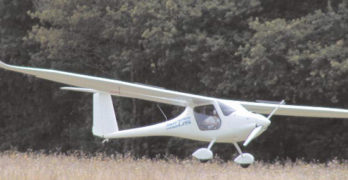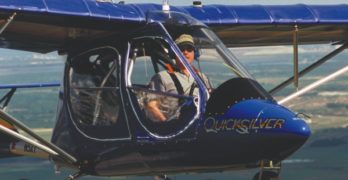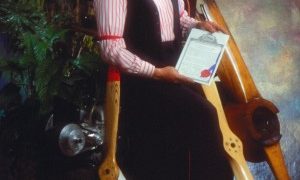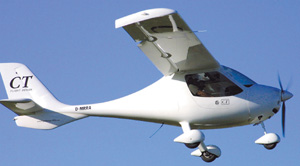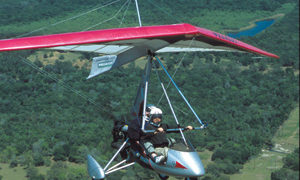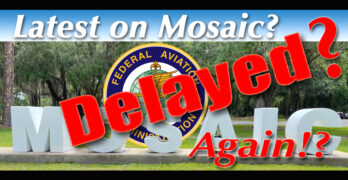Many excellent aircraft may be headed our way
Parlez-vous Française? Sprechen Sie Deutsche? Parlate Italiano? Fortunately, to understand European recreational aircraft you don’t need to speak French, German, or Italian. Yet the light-sport aircraft (LSA) that may interest you could come from countries where the mother tongue isn’t English.
Welcome to the globalized
world of light-sport
aircraft where the workers
who built your plane may speak
Polish, Russian, Hungarian, or
Latvian in addition to French,
German, or Italian.
Though many intriguing
ultralights come from Europe and
Americans have seen a few of these,
many are a complete surprise to
Yankee pilots. That will change.
Last year after EAA AirVenture
Oshkosh 2002 ended, I traveled to
Blois (pronounced Blwah), France, a
town about 200 kilometers south of
Paris. There I attended the 22nd
salon (or air show) that organizers
present at this location each year in
late summer. Let’s take a walk
around the salon at Blois.
Search Results for : Flight Design
Not finding exactly what you expected? Try our advanced search option.
Select a manufacturer to go straight to all our content about that manufacturer.
Select an aircraft model to go straight to all our content about that model.
First to Achieve Light-Sport Aircraft Status?
Discounting coordination qualities, steep turns, well, all turns went very well in the GT 500; it is very precise in handling. You can always point the plane where you wish.
Many pilots, especially those trained in general aviation aircraft, love the yoke. I much prefer a joystick. This is personal preference, but you can’t fault the execution of the yoke arrangement in the GT 500. Like all components, it’s very well done.
Since I’d just flown the Flight Design CT before the
GT 500, comparisons were easy. Handling in the composite CT aircraft was much more fluid (though that may not suit everyone). The CT could also fly nearly as slowly over the fields as the GT 500, showing the possibilities in new aircraft designs.
The GT 500 behaved very properly at speed. Cruising at 90 mph indicated, the design felt very solid and gave every assurance. However, at 4,200 rpm and 50 to 55 mph, I experienced almost a continuous shudder that seemed to come from the tail.
Chuck’s Patented Reduction Drive?
Chuck’s Patented Reduction Drive?
Back when ultralights were new, most engine/prop combinations were direct drive. General aviation aircraft engines are direct drive. Of course, these run at slower revolutions so the prop speed isn’t excessive. On a high-revving 2-stroke engine, direct-drive props (commonly 36-inch diameters) are spinning so fast the prop tips create a lot of noise.
When I owned and flew a Flight Designs Jet Wing trike back in 1982, that direct-drive Kawasaki 440 engine and prop were so loud my neighbors complained and I had to cease flying except during certain hours.
To the rescue came Chuck Slusarczyk and his invention. The funny thing is, his patent is not for the reduction drive as many think and as this sidebar’s title suggests.
Even before he designed his groundbreaking Hawk, Chuck developed and was the first to use an “ultralight” reduction drive. His early experience was during the days of experimentation of powered hang gliders.
Product Lines from July 2002
ST. PAUL, MINN. — The big Florida aerotow meets are now history. Oleg Bondarchuk performed well taking his Aeros Combat 2 to the top of both meets, an impressive accomplishment when flying against Manfred Ruhmer and a large field of talented pilots.
Yankee Paris Williams and his Icaro MR700WRE has also confirmed his position at the top of Team USA, adding a fine Second Place to his Third Place finish at Wallaby the week prior. Other great finishes by Americans included Glen Volk in 3rd on his Litespeed and Curt Warren in 5th also on a Litespeed.
*** In fact, Moyes had itself a terrific representation at Quest. The Australian manufacturer mustered an even greater field at Quest (35% of flex wings) after holding the top position at Wallaby with 29%. Competition has always been a strong suit for Moyes and it seems to have a firm grip on that mantle as the 2002 season starts out.
Fixed -Wing or Flex-Wing
This month I wrote a pilot’s report about two widely different aircraft, both of which are imported by Rollison Airplane Company. Here’s how I handled it.
Every “Ultralight Flying! Pilot’s Report” has common elements: a main article, photos and photo legends, specifications, and our exclusive “Report Card.” Because the two subject flying machines are so different this month, I’ve prepared a “Report Card” for each aircraft. I did the same for specifications as the standard and optional features obviously differ too much for grouping.
In the main article, I take alternate looks at the two flying machines as a way to observe their differences, but further how they each have their benefits.
I also selected more photos – even though Ultralight Flying! reports regularly present many photos of ultralights being reviewed as readers often say that photos are a key informative element.
Because reviewing two different craft makes for a longer pilot report, I’ve somewhat abbreviated both the main article and the twin “Report Cards.”
Quite a few general aviation pilots recognize that ultralights offer a different way to fly| and that’s precisely what they like about them.
Flex-Wing or Fixed Wing
This month I wrote a pilot’s report about two widely different aircraft, both of which are imported by Rollison Airplane Company. Here’s how I handled it.
Every “Ultralight Flying! Pilot’s Report” has common elements: a main article, photos and photo legends, specifications, and our exclusive “Report Card.” Because the two subject flying machines are so different this month, I’ve prepared a “Report Card” for each aircraft. I did the same for specifications as the standard and optional features obviously differ too much for grouping.
In the main article, I take alternate looks at the two flying machines as a way to observe their differences, but further how they each have their benefits.
I also selected more photos – even though Ultralight Flying! reports regularly present many photos of ultralights being reviewed as readers often say that photos are a key informative element.
Because reviewing two different craft makes for a longer pilot report, I’ve somewhat abbreviated both the main article and the twin “Report Cards.”
Quite a few general aviation pilots recognize that ultralights offer a different way to fly| and that’s precisely what they like about them.
Affordable and Speedy — Saberwing from Azalea plus Spyder Engine
After taking an airshow sabbatical during all of 2024, I was pleased to discover an aircraft at Sun ‘n Fun 2025 that I had never reviewed.
Welcome to Saberwing, an affordable composite kit from Azalea Aviation, which distinguishes itself by also providing an engine to fit the aircraft. Oh, and it’s affordable!
Let’s discover more.
Saberwing and Spyder
Based in Quitman, Georgia, Azalea’s Saberwing was designed for amateur builders seeking a speedy two seater in the LSA description. It has not qualified as a Special LSA but designer and company CEO Bill Clapp said he will consider meeting Mosaic LSA standards when released later this year.
Introduced ten years ago at Sun ’n Fun 2015, this low-wing EAB is “designed to address challenges in the kit aircraft market, emphasizing a simplicity to the kit’s components with fast assembly (500-1,000 hours).” For comparison, RVs often take more than 3,000 hours.
Mosaic! …Or No Mosaic (Yet)? — That Is the Question
OK, so we have a new U.S. President and Trump often promised to “Eliminate 10 new rules for every new one proposed.”
On the campaign trail, this was only promises, such as every politician makes. Now comes reality. Will our new president do what he said?
Regular readers will recognize Roy Beisswenger. Roy and I made several trips to Washington, DC in an attempt by LAMA, the Light Aircraft Manufacturers Association, to encourage FAA to make changes to the then-10-year-old Sport Pilot / Light-Sport Aircraft regulation. Our work, starting in 2014, began a few years before anyone knew anything about Mosaic. Being involved for ten years provided lots of knowledge about FAA rule making, leading to actions later known as Mosaic.
In his day job, Roy is the proprietor of Easy Flight, the nation’s premiere powered parachute educator and flight trainer. Follow the link to learn more.
Shark Attack — Review and Video of a Striking Mosaic-Ready Aircraft
Readers who scour the Internet looking for fascinating Light-Sport Aircraft may already know Shark. Conceived by Jaro Dostal in the Czech Republic, this design is the latest from a man who has a long, storied history of aircraft for the light aviation set.
Jaro’s work included the Skyboy from the early days of LSA and later the MD-3 SportRider. Both won approval from many pilots.
All Jaro’s designs have one common easily-seen design characteristic: his shark fin vertical tail. Of course, this one is no different in that respect but it is the first to openly embrace the name. With this speedy aircraft already flying in North America and with more on the way, I couldn’t resist the compelling “Shark Attack” title. Let’s check it out.
Shark.Aero
Shark is built at a factory in the country of Slovakia in a region said to be well known for producing innovative designs.
Year-End Review of Changes Expected with FAA’s Mosaic Rule — in Mid-2025
Let me do the obvious first. Mosaic has for some weeks been in what agency personnel call their “quiet period.” This is when FAA is finalizing a regulation and will no longer respond to info requests. Public comment windows are long closed.
Short take — We know only a little more than we did a few months back. Major questions remain about what license level of pilot can fly what configuration of Mosaic LSA using what medical. We have no new information on these questions. In addition, many in the LSR-M mechanic community also have many questions and concerns.
The public had a chance to comment, and lots of you did. Now, after reading every single comment, FAA rule writers are head down preparing the final version
Coming in Mid-205
Word from those who talk to FAA about other matters say the Mosaic reg is proceeding well. It is expected by “mid-2025,” though such pronouncements have often proved premature.
- « Previous Page
- 1
- …
- 41
- 42
- 43
- 44
- 45
- …
- 147
- Next Page »


